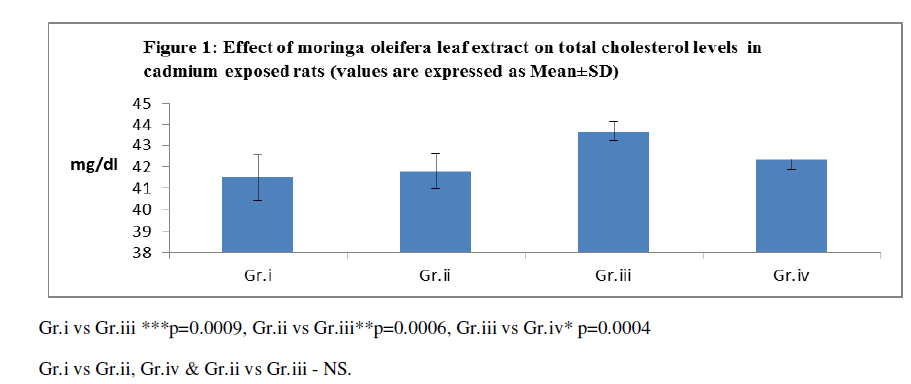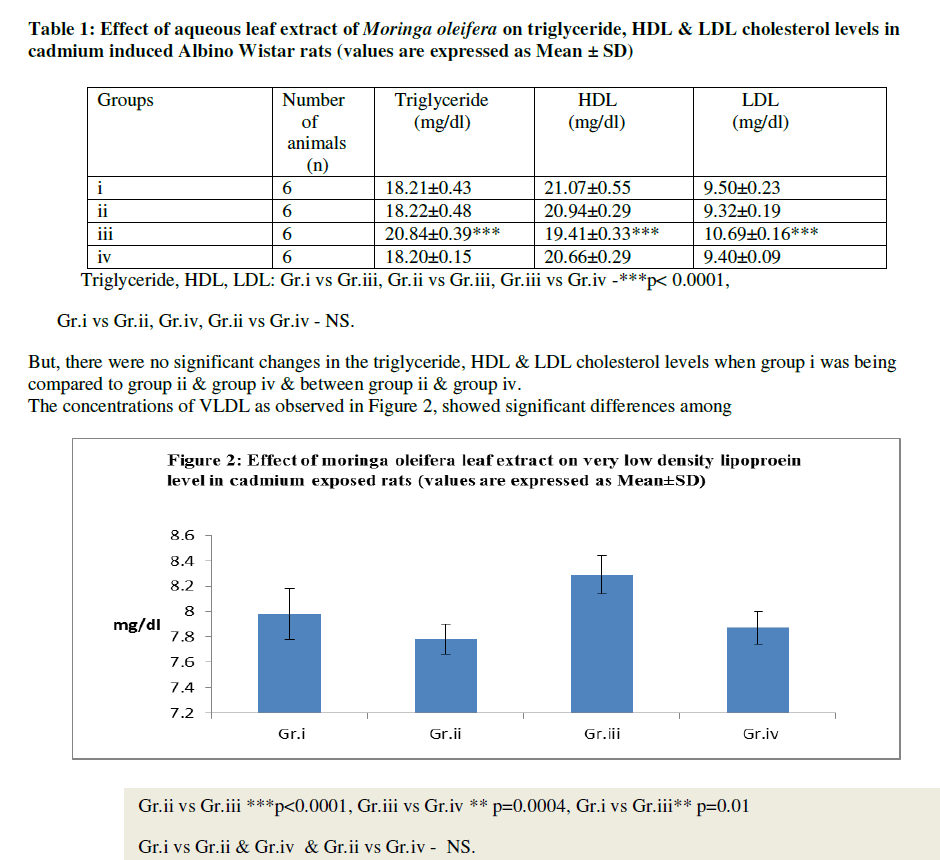ISSN ONLINE(2319-8753)PRINT(2347-6710)
ISSN ONLINE(2319-8753)PRINT(2347-6710)
Pratik Kumar Chatterjee1, Vinodini N.A2, Anwar Amemarsoofi3, Nayanatara AK2, Sheila R. Pai4, Suman
VB2
|
| Related article at Pubmed, Scholar Google |
Visit for more related articles at International Journal of Innovative Research in Science, Engineering and Technology
Cadmium, an extremely toxic metal leads to a large number of health conditions like, diabetes, cancer, cardiovascular diseases etc., Studies have shown that exposure to cadmium causes hyperlipidaemia & also hypercholesterolemia. Moringa oleifera, a ‘Miracle Tree’, is having a wide range of medicinal uses like, anti-oxidant, hepato-protective, cholesterol lowering actions, etc., with a high nutritional value. Therefore, the present study was designed to elucidate the effect of aqueous leaf extract of Moringa oleifera on lipid profile in cadmium exposed adult Wistar rats. Twenty four male Wistar Albino rats were divided into four groups. Pre-treatment with Moringa leaf extract in cadmium exposed rats showed a significant decrease in the levels total cholesterol, triglyceride, HDL, LDL & VLDL as compared to the untreated control group. Therefore, the present study suggests that pre-treatment with Moringa oleifera leaf extract has a positive effect in lowering the lipid profile in cadmium exposed rats.
Keywords |
| Cadmium, Moringa oleifera, HDL, LDL, VLDL. |
INTRODUCTION |
| Cadmium (Cd), a heavy metal, found in the environment as a constituent of ocean water, surface water & ground water, is one of the important occupational & environmental toxicants with a wide variety of industrial applications. Cadmium levels in the environment have increased dramatically in the last few years as it is naturally emitted into the environment through volcanic activities, forest fires & generation of sea-salt aerosols1. Since cadmium is not degraded in the environment, it enters into the food chain also, increasing the risk of human exposure constantly2. This metallic toxicant accumulates in the target organs & affects cell physiology & growth3, 4. Exposure to cadmium significantly alters the concentrations of total cholesterol, HDL (high density lipoprotein), LDL (low density lipoprotein), triglyceride & VLDL (very low density lipoprotein) cholesterol fraction in the blood also5. Medicinal plants have been used by all civilizations as a source of medicines since ages. In the recent times, there has been growing interest in exploiting the biological activities of different medicinal herbs, due to their natural origin, cost effectiveness & lesser side effects6. Among myriad of plants Moringa oleifera of Moringaceae family is an important tropical crop that is used by humans as food, medicine & in oil production. It is a highly valued plant reported to have various biological activities7. |
| A. Review of literature |
| Anthropogenically, cadmium enters into the environment by non-ferrous mining & refining processes, manufacture & application of phosphate fertilizers, fossil fuel combustion, production & use of nickel-cadmium batteries, etc.,8, 9. Cadmium induces disorders in the humoral & cellular immune responses10, 11, 12. Studies have shown that a positive correlation exists between environmental & occupational exposure to this toxic heavy metal with cardiovascular disease mortality13, 14. Cadmium exposure causes a dose-dependent increase in the plasma triglyceride levels with increased concentrations of LDL & VLDL cholesterol fractions which might be due to cadmium-induced oxidative stress leading to a high level of hydroperoxides (LOOH), low paraoxonase activity, etc., So, the toxicity of cadmium causes disruption of the lipid metabolism in addition to perturbation of the pro-inflammatory cytokine levels5. A triglyceride (triacylglycerol/TAG/triacylglyceride) is an ester derived from glycerol & three fatty acids15. Elevated levels of triglycerides are associated with atherosclerosis & often predispose to cardiovascular disease. It is also seen that hypertriglyceridemia by itself is usually symptomless but may be associated with xanthomas16. LDL particles are often termed as bad cholesterol because they have been linked to atheroma formation whereas high concentrations of HDL are often referred to as good cholesterol, as it can remove cholesterol from cells & atheroma & hence can offer protection17. So, elevated levels of the LDL & VLDL fractions of cholesterol can also be referred to as atherogenic (prone to cause atherosclerosis)18. From time immemorial man was dependent on plants for medicine as plants are said to be as old as mankind itself. The plant kingdom also serves as a rich source of organic compounds, many of which have been used for medicinal purposes19. Moringa oleifera is one such tree which is used for various purposes like, medicinal, cooking, oils, cosmetics, etc.,19 Extracts from different parts of this plant have shown radical scavenging & antioxidant properties19. It has also been reported that the leaves possess hypo-cholesterolemic activity & hypolipidemic effects as it is found to lower serum cholesterol, triglyceride, VLDL & LDL cholesterol levels with an increase in the HDL cholesterol levels19. But, the effects of Moringa oleifera leaves against cadmium induced alterations in the lipid profile in rats have not yet been studied. |
| Therefore, the present study was carried out to determine the effect of aqueous leaf extract of Moringa oleifera on lipid profile in cadmium exposed adult Wistar rats. |
MATERIALS&METHODS |
| All the experimental procedures & maintenance of the animals were confined to the strict guidelines of the Institutional Ethics Committee & to that of Federal laws for the use of animals, in the experiment. The study was conducted in the year (2011-2012). Biochemical assay was carried out with the chemicals which were obtained from Durga Laboratories, Mangalore, Karnataka, India. |
| A. Plant materials |
| Samples of the leaves of the plant Moringa oleifera were collected from the plantations in Mangalore, Karnataka, India. They were also identified first & then authenticated by a plant taxonomist. |
| B. Preparation of extract |
| A thorough cleaning of the leaves of the plant was done followed by drying in the room temperature & crushing it into coarse powder. About 20 g of powder was taken & soaked separately in 100 ml of water & chloroform by keeping it in a Shaker for 3 days. It was filtered through cheese cloth & reduced to 10% of its original volume (organic solvent)., , The filtrate was then concentrated in vacuum using a rotary evaporator. The aqueous extract was dried using water bath. The whole process of extract preparation was carried out in Yenepoya Medical College, Yenepoya University, Mangalore, Karnataka, India 20. |
| C. Experimental animals |
| Adult male Wistar Albino rats of were taken into the study. The duration of the study was for ten days. These animals of (180-200) g weight were obtained from the animal house of Kasturba Medical College (KMC), Manipal University (MU), Mangalore, Karnataka, India. The ethical approval was taken from the Institutional Animal Ethical Committee (IAEC). The Institutional Experimental Animal Laboratory was used for housing these experimental animals. They were also having free access to food (standard diet) & water. |
| D. Experimental design |
| Aqueous leaf extract of Moringa oleifera was used. A total of twenty four (24) adult male Wistar Albino rats of (180- 200) g were taken & they were then broadly divided into four (4) groups. Each group consisted of six (6) animals, as follows: |
| Group i - control group, received normal saline only. |
| Group ii - experimental control group, pre-treated (oral) with Moringa oleifera leaf extract, (100 mg/kg/bw) for 10 days. |
| Group iii - received a single oral dose of cadmium chloride (10 mg/kg/bw). |
| Group iv - pre - treated with M. oleifera leaf extract (100 mg/kg/bw) for 10 days, followed by cadmium chloride (10 mg/kg/bw) given orally for one day. |
| E. Biochemical estimation |
| 2 ml of blood was collected directly via cardiac puncture, under aseptic precautions using 23 G needles. Plasma concentrations of total cholesterol, triglycerides, HDL, LDL & VLDL cholesterol fractions were measured by using standard methods with commercially available kits5. |
| F. Statistical analysis |
| The data were expressed as means ±SD from 6 animals per group. Statistical significance was calculated by using the student ‘t’ test with a p value < 0.05 taken as significant. |
RESULT |
| Figure 1 shows the changes in the total cholesterol levels on treatment with aqueous leaf extract of Moringa oleifera prior to cadmium exposure. It is evident that, the total cholesterol |
 |
| level was significantly increased in the cadmium alone treated group in comparison to normal control & experimental control. However, a significant decrease was seen in group iv, where the animals had undergone prior treatment with aqueous leaf extract of Moringa oleifera prior to cadmium exposure when compared to group iii. But the total cholesterol level did not show any significant difference between group i, ii & iv. The effects of Moringa oleifera leaf aqueous extract on triglyceride, HDL & LDL cholesterol levels in cadmium induced adult Wistar Albino rats are depicted in Table 1. A significant increase (p< 0.0001) in the levels of triglyceride & LDL cholesterol & decrease (p< 0.0001) in the HDL cholesterol levels were observed in group iii when compared to group i & group ii respectively. Opposite effects, i.e., a significant decrease (p< 0.0001) in the triglyceride & LDL cholesterol levels & increase (p< 0.0001) in the HDL cholesterol levels were seen when group iii was being compared to group iv. |
 |
| the groups, i.e., the VLDL levels were increased in group iii as compared to group i & ii but decreased in group iv when compared to group iii. Also, changes were observed between groups i, ii & iv, but were not significant. |
DISCUSSION |
| Evidence abound that cadmium exposure alters the lipid profile5. Our study showed that plasma total cholesterol levels were significantly elevated along with triglyceride, LDL & VLDL cholesterol fractions & a significant reduction in the HDL cholesterol level, in the cadmium exposed group, suggesting that the lipid profile was affected by cadmium exposure. Moringa oleifera has been advocated for centuries for its nutritional, medicinal & industrial uses19. It is well known that different parts of this plant possess various therapeutic properties like, hypo-cholesterolemic, hypolipidemic, anti-inflammatory, anti-cancer, etc.,19 The present study revealed that aqueous leaf extract of Moringa oleifera has an amelioratic effect on lipid profile as on pre-treatment with Moringa oleifera leaf extract showed a decrease in the total cholesterol level, triglyceride, LDL & VLDL cholesterol fractions with an increase in the HDL cholesterol levels in cadmium exposed rats. This is in accordance with previous studies which showed that Moringa oleifera leaf extract has got a profound hypolipidemic activity mostly due to its potential to control the mechanisms involved in elimination of lipids from the body 21, 22. |
CONCLUSION |
| The present study reveals that Moringa oleifera leaf extract has a beneficial effect on lipid profile in cadmium exposed rats. |